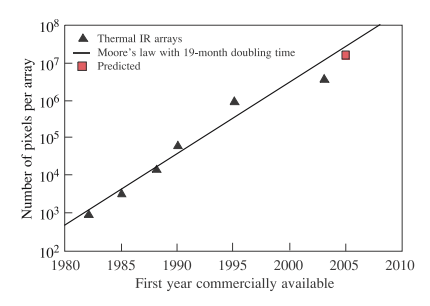Hitherto, two families of multielement infrared (IR) detectors are used for principal military and civilian infrared applications; one is used for scanning systems (first generation) and the other is used for staring systems (second generation). Third generation systems are being developed nowadays. In the common understanding, third generation IR systems provide enhanced capabilities like larger number of pixels, higher frame rates, better thermal resolution as well as multicolour functionality and other on-chip functions.
Multicolour capabilities are highly desirable for advance infrared (IR) systems. Systems that gather data in separate IR spectral bands can discriminate both absolute temperature and unique signatures of objects in the scene. By providing this new dimension of contrast, multiband detection also enables advanced colour processing algorithms to further improve sensitivity above that of single-colour devices. This is extremely important for the process of identifying temperature difference between missile target, war heads, and decoys. Multispectral IR focal plane arrays (FPAs) can also play many important roles in Earth and planetary remote sensing, astronomy, etc. Currently, multispectral systems rely on cumbersome imaging techniques that either disperse the optical signal across multiple IR FPAs or use a filter wheel to spectrally discriminate the image focused on single FPA. These systems contain beamsplitters, lenses, and bandpass filters into the optical path to focus the images onto separate FPAs responding to different IR bands. Also complex alignment is required to map the multispectral image pixel for pixel. Consequently,these approaches are expensive in terms of size, complexity, and cooling requirements.
Recently, type II InAs/GaInSb superlattices have emerged as third candidate for third generation infrared detectors. Whether the superlattice IR photodetectors can outperform the “bulk” narrow gap HgCdTe detectors is one of the most important questions for the future of IR photodetectors.
Two families of multielement detectors can be considered for principal military and civilian IR applications; one used for scanning systems and the other used for staring systems. The scanning system, which does not include multiplexing functions in the focal plane, belongs to the first generation systems.
For the last 25 years, array size has been increasing at an exponential rate, following a Moore’s Law grow path (see Fig. 1), with the number of pixels doubling every 19 months. The graph shows the low of the number of pixels per SCA as a function of the year first used on astronomy for MWIR SCAs. Arrays are expected to exceed 4K x 4K format – 16 million pixels – this year, about a year later than the Moore’s Law prediction.

Fig1
Many challenges are forced IR community in developing third generation IR imagers including noise equivalent difference temperature (NEDT), pixel and chip size issues, uniformity, identification and detection ranges, etc. Here, we concentrate on advantages and disadvantages of competitive technologies of third generation photon detectors including HgCdTe photodiodes, AlGaAs/GaAs quantum well photodetectors and type II InAs/GaInSb superlattices. Special attention is devoted to material uniformity and NEDT considerations.
The distinction between integration time and the FPA’s frame time must be noted. At high backgrounds it is often impossible to handle the large amount of carriers generated over frame time compatible with standard video rates. Off-FPA frame integration can be used to attain a level of sensor sensitivity that is commensurate with the detector-limited D* and not the charge-handling-limited D*. Even though the detectivity of LWIR detectors is background limited, the readouts of today can collect only about 1% of the charge in unit cell from a flux of 1016–1017 photons/cm2s. Unit cell capacitors fill up in about 100 µs, while the frame time is on the order of 10 ms.
上一篇: 玻璃芯片上的可重构光子学
下一篇: 第三代红外光电探测器的新材料系统